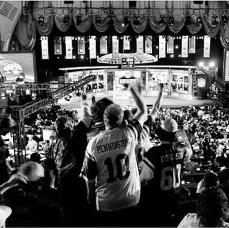By Brian Bohl
Voluminous reports were stacked inside the Jets headquarters in preparation for draft day. General manager Mike Tannenbaum said almost a week earlier that the organization evaluated over 1,400 players and compiled 5,000 reports from the scouts and coaching staff.
Despite the arduous due diligence and myriad possibilities, the Jets made only four selections after stockpiling 10 picks in the 2006 draft. In his second season with full autonomy, Tannenbaum made two trades during the NFL Draft’s first day, targeting defense one offseason after supplying the offense with an overhaul last spring.
Thanks to a 10-6 record, the Jets originally were slotted with the 25th overall selection. The NFL Draft set a dubious record as the first round finished in 6:08, breaking the 2002 mark for the longest round in the event’s history. Tannenbaum cut into the waiting time dramatically, moving up to the 14th spot to grab Pittsburgh’s Darrelle Revis, making him the first cornerback selected.
At 5-11, 204-pounds, Revis adds a defensive back who can run 40-yards in under 4.4 seconds. The Jets passed on Michigan corner Leon Hall and Texas defensive back Aaron Ross for a player who starred as a shutdown corner and a punt returner for Pittsburgh before declaring for the draft after his junior year.
“My first reaction, I just started crying,” said Revis, who might have went to his hometown Steelers with the 15th pick if the Jets failed to trade up. “It’s something I’ve dreamed about my whole life and now it’s here.”
The Jets moved up 11 spots to acquire Revis with the hope he can help a defense ranked 20th overall last season despite a six-win improvement from 2005 and a playoff berth. As coach Eric Mangini begins his second season at the helm, Tannenbaum made a separate trade with Green Bay to move up in the second round. To bolster a run-stopping game that ranked 24th out of 32 teams last season, inside linebacker David Harris was nabbed with the 47th overall entry.
Revis and Harris were the only picks through the first three rounds, as Tannenbaum collectively traded second, third, fifth and sixth round picks to complete the two trades. AFC East division-rival New England added former Pro Bowl receiver Randy Moss Sunday, meaning Tannenbaum’s desperation to snatch Revis could actually determine if the Jets can compete for the division crown.
Harris, who recorded a team-high 103 tackles for Michigan, will be counted on to contribute in the 3-4 base set defensive system that Mangini instituted as a rookie head coach in 2006. The Jets traded their other second round pick last month to Chicago, but that deal netted them starting running back Thomas Jones. All together, the Jets could conceivably gain three starters from this year’s draft class, meaning the front office chose quality over quantity.
“We had no pre-conceived notions on trading up as we did,” Tannenbaum said. “We just thought there was great opportunity both with Darrelle and David, so defensively we felt like we helped two positions. We feel like we can’t have enough corners, can’t have enough linebackers. Thomas Jones: obviously he’s going to help our production out at running back.”
Tannenbaum targeted the offensive line last year, choosing Freeport native D’Brickashaw Ferguson to anchor the left side and Nick Mangold to solidify the center position. Quarterback Chad Pennington proved he could play through an entire season without suffering an injury, and backup Kellen Clemens was a second round pick last season with the potential to possibly supplant Pennington in the future.
Leon Washington was a surprise contributor. The rookie running back emerged as the feature tailback, while Jones adds a veteran presence to the backfield. With the offense set at the skill positions, Tannenbaum targeted defense on the first day, though he provided depth for the offensive line on the second day.
With no picks through rounds 3-5, the Jets were forced to wait until 177th overall pick in the sixth round to take tackle Jacob Bender from little-known Nicholls State. Bender has good size at 6-6, 315-pounds, giving the coaching staff flexibility to use him at multiple spots, though Mangini said he probably would not be used as a center.
“He has very good toughness,” Mangini said. “I think that coming from a little bit of a smaller program, we’ll be able to continue to develop his skill set. It comes back to meeting with him and spending a day with him and seeing what he was like as a person. His football recall and his ability to learn I thought were all positives.”
Hofstra receiver Shaine Smith was still on the board when the Jets made their last pick in the seventh round. A week earlier, Smith said he had worked out for Gang Green and met with Tannenbaum and Mangini.
The Jets did indeed select a receiver, but bypassed the local product and went with Clemson wide out Chansi Stuckey. Smith went undrafted by signing a free-agent contract with the Rams immediately after the draft closed Sunday evening. Though they only added four players in the two days, Tannenbaum said the Jets will sign about 15 rookie free agents to fill out the roster, hoping one of those little-acclaimed players could be the next Marques Colston: a high-impact rookie who flew under the radar at a smaller program.
“We are the land of opportunity,” Tannenbaum said. “So, if you are not drafted, you will be hearing from us.”
In the meantime, the Jets addressed an area of need by using Revis to push struggling corner Justin Miller and provide a replacement in case veteran David Barrett is cut before the team is on the hook for his $3.6 million base salary set for 2007. Harris can team with Jonathan Vilma to revamp the linebacking corps, while Stuckey and Bender provide depth to positions stocked with holdovers from last year.

